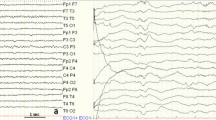Changes in EEG spectral characteristics during periods of recovery of performance in a psychomotor test during spontaneous short-term periods of waking in daytime sleep were studied in 17 healthy subjects. The test consisted of two sequentially alternating tasks: to count from 1 to 10 silently accompanied by synchronized pressing of a button, and silent counting only. The monotonous nature of the test led to a rapid decline in the level of consciousness and, in most cases, induced falling asleep. Presses serves as a behavioral indicator of the recovery of cognitive processes inhibited during sleep. Situations with small (2–5) and relatively large (6–10) numbers of button presses were compared. The start of pressing was preceded by the appearance of generalized α rhythm, which decreased during performance of psychomotor activity. The power of this rhythm was always greater in longer periods of observed behavioral activity. The end of pressing returned α-power indicators to levels seen before waking. The EEG α rhythm in decreased consciousness during short-term waking evidently characterized the action of the thalamocortical activatory mechanism and was a necessary condition for motor interaction of the body with the external environment. The absence of any differences in the frontal areas at the initial stage on performance of short-lived activity and longer-lasting activity, approaching performance of the complete cycle of presses, suggested that they are involved to the same extent during this period regardless of the number of presses. This result may provide indirect support for the notion that the observed psychomotor activity, even with a small number of presses, is not automatic and unconscious but is accompanied by reduced and fragmented consciousness.
Similar content being viewed by others
References
P. J. Tsai, S. C. Chen, C. Y. Hsu, et al., “Local awakening: regional reorganizations of brain oscillations after sleep,” Neuroimage, 102, No. 2, 894–903 (2014).
L. Peter-Derex, M. Magnin, and H. Bastuji, “Heterogeneity of arousals in human sleep: A stereo-electroencephalographic study,” Neuroimage, 123, 229–244 (2015).
J. Schwabedal, M. Riedl, T. Penzel, and N. Wessel, “Alpha-wave frequency characteristics in health and insomnia during sleep,” J. Sleep Res., 25, 278–286 (2016).
M. Ferrara, G. Curcio, F. Fratello, et al., “The electroencephalographic substratum of the awakening,” Behav. Brain Res., 167, 237–244 (2006).
C. Marzano, M. Ferrara, F. Moroni, and L. De Gennaro, “Electroencephalographic sleep inertia of the awakening brain,” Neuroscience, 176, 308–17 (2011).
L. Trotti, “Waking up is the hardest thing I do all day: Sleep inertia and sleep drunkenness,” Sleep Med. Rev., 35, 76–84 (2017).
R. Vallat, D. Meunier, A. Nicolas, and P. Ruby, “Hard to wake up? The cerebral correlates of sleep inertia assessed using combined behavioral, EEG and fMRI measures,” Neuroimage, 184, 266–278 (2019).
H. Ikeda and M. Hayashi, “Effect of sleep inertia on switch cost and arousal level immediately after awakening from normal nocturnal sleep,” Sleep Biol. Rhythms, 6, 120–125 (2008).
E. A. Cheremushkin, N. E. Petrenko, M. S. Gendzhalieva, et al., “EEG activity preceding spontaneous recovery of psychomotor activity after microsleep episodes,” Ros. Fiziol. Zh., 105, No. 8, 1002–1012 (2019).
J. R. Hale, T. P. White, S. D. Mayhew, et al., “Altered thalamocortical and intra-thalamic functional connectivity during light sleep compared with wake,” Neuroimage, 125, 657–667 (2016).
V. B. Dorokhov, “α spindles and K-complex-phasic activation patterns during spontaneous recovery of impaired psychomotor activity at different stages of drowsiness,” Zh. Vyssh. Nerv. Deyat., 53, No. 4, 502–511 (2003).
V. B. Dorokhov, D. G. Malakhov, V. A. Orlov, and V. Ushakov, “Experimental model of study of consciousness at the awakening: fMRI, EEG and behavioral methods,” in: Biologically Inspired Cognitive Architectures. Proceedings of the Ninth Annual Meeting of the BICA Society (2018), pp. 82–87.
M. K. Kozlov, “Assessment of the validity of variational characteristics of pre- and poststimulus EEG by the chi-square test,” Zh. Vyssh. Nerv. Deyat., 59, No. 2, 281–290 (2009).
M. Steriade, D. A. McCormick, and T. J. Sejnowski, “Thalamocortical oscillations in the sleeping and aroused brain,” Science, 262, 679–685 (1993).
P. Halász, M. Terzano, L. Parrino, and R. Bodizs, “The nature of arousal in sleep,” J. Sleep Res., 13, 1–23 (2004).
M. Petrides and D. G. Pandya, “The frontal cortex,” in: The Human Nervous System, G. Paxinos and U. Mai (eds.), Academic Press, Amsterdam (2004), pp. 950–972.
E. A. Kostandov, “The role of implicit estimation of time intervals and set plasticity in facial expression processing,” Cogn. Syst. Monogr., 25, 349–366 (2015).
J. Morales, H. Lau, and S. M. Fleming, “Domain-general and domain- specific patterns of activity supporting metacognition in human prefrontal cortex,” J. Neurosci., 38, No. 14, 3534–3546 (2018).
L. Nyberg, “Cognitive control in the prefrontal cortex: A central or distributed executive?” Scand. J. Psychol., 59, No. 1, 62–65 (2018).
G. Pfurtscheller and C. M. Neuper, “Movement and ERD/ERS,” in: The Bereitschafts Potential. Movement-Related Cortical Potentials, M. Jahanshahi and M. Hallet, Kluver Academic Plenum Publishers, New York (2003). pp. 191–206.
E. A. Kostandov, E. A. Cheremushkin, I. A. Yakovenko, and N. E. Petrenko, “Relationships between the flexibility of cognitive performance and the α-rhythm response to conditioning stimuli,” Human Physiol., 41, No. 5, 468–477 (2015).
P. T. George, “The psycho-sensory wake drive – a power source for power naps and other common sleep–wake phenomena: a hypothesis,” Sleep Breath. Rev., 22, No. 1, 41–48 (2018).
P. Fazekas and M. Overgaard, “Multidimensional Models of Degrees and Levels of Consciousness,” Trends Cogn. Sci., 20, No. 10, 715–716 (2016).
P. Fazekas and M. Overgaard, “Multiple factors and multiple mechanisms determine the quality of conscious experiences: a reply to Anzulewicz and Wierzchon,” Cogn. Sci., 42, No. 6, 2101–2103 (2018).
Author information
Authors and Affiliations
Corresponding author
Additional information
Translated from Rossiiskii Fiziologicheskii Zhurnal imeni I. M. Sechenova, Vol. 106, No. 3, pp. 342–355, March, 2020.
Rights and permissions
About this article
Cite this article
Cheremushkin, E.A., Petrenko, N.E., Gendzhalieva, M.S. et al. EEG Characteristics during Short-Term Spontaneous Waking Periods of Different Durations with Changes in Psychomotor Activity Induced by Falling Asleep. Neurosci Behav Physi 50, 1232–1238 (2020). https://doi.org/10.1007/s11055-020-01024-8
Received:
Revised:
Accepted:
Published:
Issue Date:
DOI: https://doi.org/10.1007/s11055-020-01024-8




